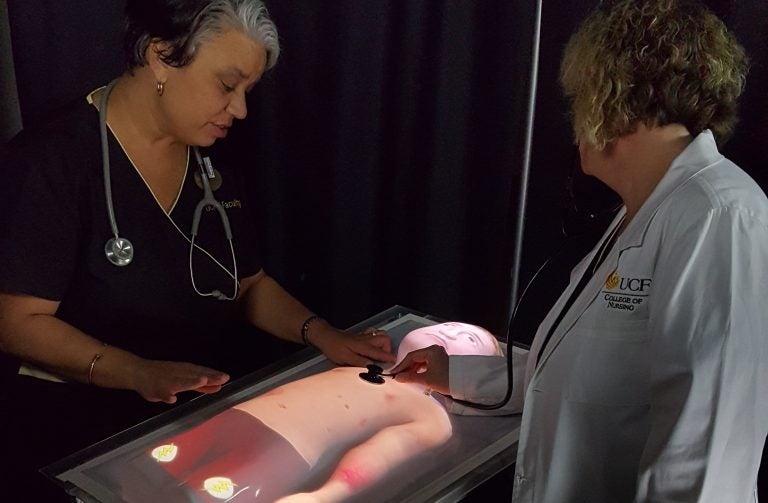It’s a fact. Children behave and communicate differently than adults.
For healthcare providers, the verbal and nonverbal nuances of children’s behavior can be critically important for diagnosis and treatment. However, current training tools are limited in their capability to replicate a pediatric patient.
Standardized child patients, or actors, are not readily available. Mannequins have a static appearance. Computer-based simulators lack physical shape. That’s where a new innovative simulated training tool can help.
A team of UCF researchers are currently developing a transportable pediatric version of the patented physical-virtual patient bed (PVPB), which brings humanity to simulation. This smaller-scale innovation effectively brings a pediatric patient to life, in physical size and behavior thanks to projectors and other common components controlled by sophisticated programming. Currently, only two prototypes exist in the world – both at UCF.
“What makes these simulated ‘patients’ unique is their ability to support high level responses, such as speech, emotions and facial expressions, as well as low level responses such as breathing and temperature,” said Salam Daher, a graduate research assistant who recently received a 2018 NCWIT Aspirations in Computing Collegiate Award for her contributions to the project. “Additionally, the technology allows the instructor to control gender, age, ethnicity and various medical conditions essentially with a push of a few buttons.”
Bringing a human of any age to life through simulation can be complex. “One of the most significant features of the PVPB is its ability to sense and respond to touch,” said Gregory Welch, the Florida Hospital Endowed Chair in Healthcare Simulation at the UCF College of Nursing, who is leading the development of the PVPB and the two transportable prototypes. “For example, if a student touches an arm, the ‘patient’ will look at them and respond.”
“In nursing education, we like to have ‘patients’ mimic what would be found in real life,” said Mindi Anderson, an associate professor of nursing and one of the world’s leading experts in healthcare simulation education. “This includes what would be seen, heard and felt on a patient, as well as the ability to interact to gain insights from verbal and nonverbal communication cues.”
Like its larger adult counterpart, the pediatric PVPB has the ability to provide critical training for difficult-to-diagnose conditions such as child abuse and sepsis, where symptoms may be relatively subtle. “It is important for nursing students to participate in simulations for diagnoses that are common to see or uncommon, but terribly important that they don’t miss,” adds Anderson.
“Through this simulated tool, we are able to bring a pediatric ‘patient’ to life for healthcare professionals to train in a safe environment,” said Welch. “Compared to our original adult-sized PVPB, our pediatric prototypes are relatively transportable, which allows us to bring this innovative technology to area hospitals for on-site training.”
“That is our goal right now,” adds Welch. “In the future, I think there is great benefit and potential for it to be developed and used at other simulation centers and universities around the country and the world to train students and healthcare providers.”
“The use of simulation as a learning technique brings a wealth of benefits to students and providers,” said Laura Gonzalez, director of simulation at the college and an advanced expert in healthcare simulation education. “This is an exciting evolution in how the technology can be used in the future.”
